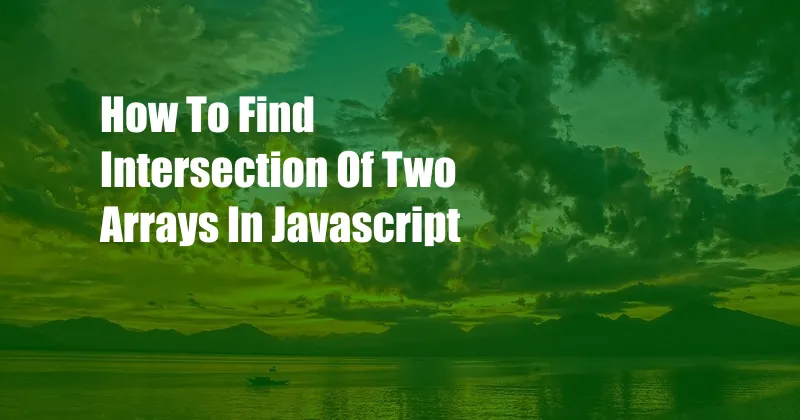
Finding the Intersection of Two Arrays in JavaScript: A Comprehensive Guide
Imagine yourself standing amidst a bustling marketplace, the aroma of spices mingling with the vibrant chatter of vendors. As you navigate the maze-like alleys, you notice that your path frequently intersects with that of a friend. Intrigued, you decide to keep track of the items you both possess, hoping to uncover the secret of your serendipitous encounters.
Similarly, when working with arrays in JavaScript, we often encounter scenarios where we need to determine the common elements shared between them. Finding the intersection of two arrays becomes crucial in various applications, ranging from data analysis to set operations. In this article, we will delve into the fascinating world of array intersections, exploring its definition, implementation, and practical applications. So, buckle up and prepare to unravel the mysteries that lie at the crossroads of arrays.
The Intersection of Arrays: A Conceptual Overview
An array is an ordered collection of elements that can store data of various types. The intersection operation on two arrays results in a new array that contains only the elements that are present in both the original arrays. In essence, it identifies the overlap between two sets of data.
Understanding the concept of the array intersection using a graphical representation can be highly effective. Imagine two overlapping circles, each representing an array. The intersection point, where the circles overlap, corresponds to the elements that belong to both arrays. This visual analogy provides a concrete understanding of the intersection operation.
Implementing the Array Intersection Algorithm
Now, let’s dive into the practicalities of implementing the array intersection algorithm in JavaScript. There are several approaches to accomplishing this task, each with its advantages and drawbacks. We will explore two commonly used methods:
The Brute-Force Approach: A Straightforward Method
The brute-force approach, while straightforward, involves iterating over both arrays and comparing each element of the first array with every element of the second array. This method, although easy to implement, can be computationally expensive for large arrays.
function arrayIntersectionBruteForce(arr1, arr2)
const intersection = [];
for (let i = 0; i < arr1.length; i++)
for (let j = 0; j < arr2.length; j++)
if (arr1[i] === arr2[j])
intersection.push(arr1[i]);
return intersection;
The Set Intersection Approach: Leveraging Set Data Structures
JavaScript provides a built-in Set data structure that can be utilized for more efficient array intersection operations. The Set data structure guarantees that each element is unique, eliminating the need for explicit comparisons. By converting the arrays into sets and then using the intersection() method, we can obtain the common elements.
function arrayIntersectionSet(arr1, arr2) const set1 = new Set(arr1); const set2 = new Set(arr2); const intersection = [...set1].filter((item) => set2.has(item)); return intersection;
Exploring the Nuances of Array Intersections
While array intersections appear straightforward, there are a few nuances that deserve attention:
Duplicate Elements: Handling Repeated Occurrences
By default, the intersection operation treats each element as unique, meaning that duplicate elements will occur only once in the resulting array. However, if preserving duplicate elements is essential, a modified approach is required.
Data Types: Ensuring Compatibility
It's important to ensure that the elements in both arrays are of the same data type. Mixing different data types, such as strings and numbers, may lead to unexpected results or errors.
Best Practices for Array Intersection Operations
Here are some tips to optimize the performance of array intersection operations:
Choose the Appropriate Algorithm:
Select the algorithm that best suits the size and nature of your arrays. The brute-force approach is suitable for small arrays, while the set intersection approach excels with larger datasets.
Leverage Set Data Structures:
Sets offer faster lookup times than arrays, making them ideal for intersection operations. Consider converting your arrays to sets before performing the intersection.
Minimize Unnecessary Iterations:
Avoid redundant iterations by using techniques like early termination or caching. This can significantly improve performance for large arrays.
Frequently Asked Questions (FAQs)
Q: How can I find the intersection of two unsorted arrays?
A: Use the set intersection approach, as it does not rely on the order of elements.
Q: What if I want to preserve duplicate elements in the intersection?
A: Modify the algorithm to count the occurrences of each element in the first array and then check for its presence in the second array.
Q: How can I handle arrays with different data types?
A: Convert the elements to a consistent data type using type coercion or explicit conversion.
Conclusion
Congratulations! You have now embarked on a journey into the world of array intersections, unlocking a powerful tool for data analysis and set operations. Remember, the key to mastering this technique lies in understanding the fundamental concepts and choosing the most appropriate approach for your specific needs. As you continue to explore the vast realm of JavaScript, never hesitate to delve deeper into the intricacies of array manipulations. Remember, knowledge is the ultimate intersection of curiosity and perseverance.
Before we bid you farewell, we would like to inquire: Has this article ignited your passion for array intersections? Do you have any further questions or would you like to share your insights and experiences? Let's continue the conversation in the comments section below and unravel the mysteries of array intersections together.